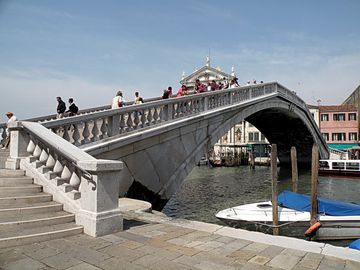

The Scalzi Bridge, named after the church in front of which it stands, is one of the four bridges to extend over the Grand Canal. It was built third in chronological order, after the Accademia Bridge.
The first bridge that stood on this site, connecting Sestiere Cannaregio to Sestiere Santa Croce, was constructed in 1858 during the Austrian occupation, at a time when the city was undergoing heavy urban redesigning. It was built out of metal and stood four meters above the canal. However, this bridge was neither practical nor aesthetically pleasing: boats with high masts could not navigate under it and its cumbersome industrial style clashed with the graceful architecture of the surrounding buildings. The metal also started decaying after a few years.
By the time the Fascist regime came to power in Italy in the 1920's, it was obvious that the Austrian bridge had to be substituted. The commission was given to Brescian architect Eugenio Miozzi, who built the new bridge, using white Istrian marble, in a span of two years. The inauguration took place in October 1934.
The Scalzi Bridge is the first Venetian bridge that tourists usually ascend after getting off the train. It offers a splendid view of the Grand Canal and the marvelous palaces lining it on both sides.